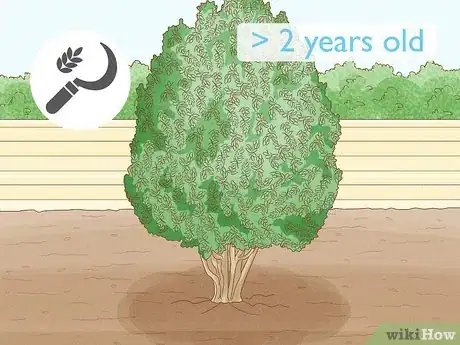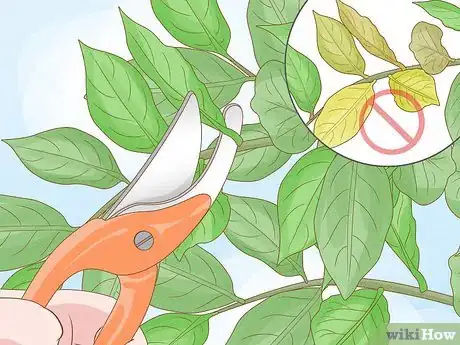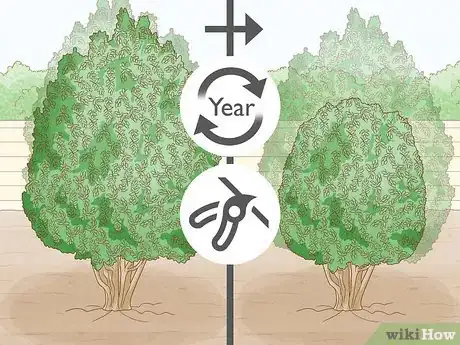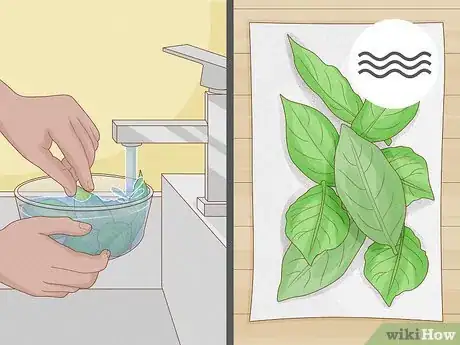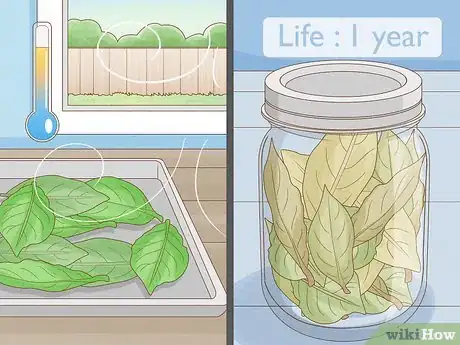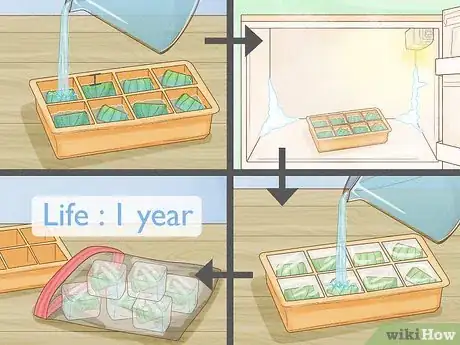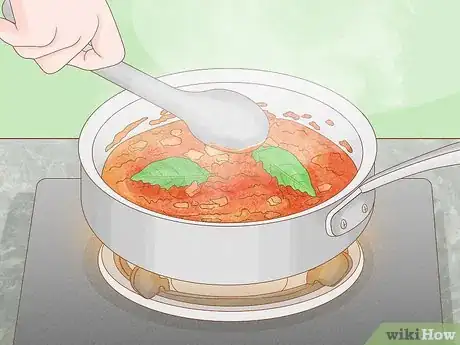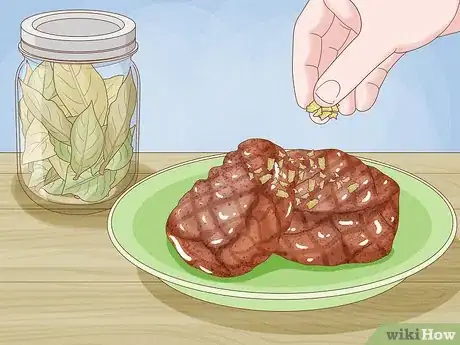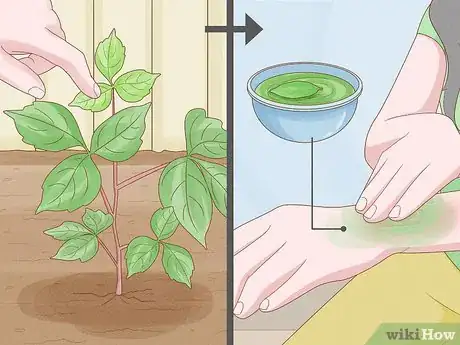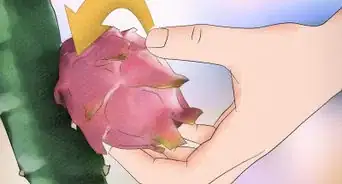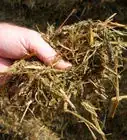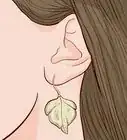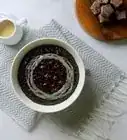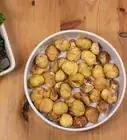X
wikiHow is a “wiki,” similar to Wikipedia, which means that many of our articles are co-written by multiple authors. To create this article, volunteer authors worked to edit and improve it over time.
There are 9 references cited in this article, which can be found at the bottom of the page.
This article has been viewed 3,148 times.
Learn more...
After planting your bay laurel tree and watching the dark-green shrub grow, you’re probably very excited to start harvesting. You can’t wait to flavor your soups, pasta sauces, and stews with your garden fresh herb. But how do you know when your bay tree is ready to harvest, and what do you do with the leaves once they’re in your hands? Keep reading to find out!
Steps
Method 1
Method 1 of 3:
Harvesting Bay Leaves
-
1Harvest leaves from a bay tree that is at least two years old. Wait until your bay tree is at least 2 years old before you start harvesting from it. Mature bay leaves have the most flavor.[1]
-
2Cut off leaves at the stem to harvest them. It’s as easy as it sounds! Take a pair of scissors or pruners and snip off a leaf. Be careful not to bruise the tree by gently moving its branches and leaves. A bruised plant can lead to future damage.[4]
- Leaves don’t need to be a specific size to be harvested. However, larger leaves will hold the most flavor. If you notice the leaves are yellow in color, do not harvest them as they will shed from the tree naturally. These leaves are older and most likely caused by a nutrient deficiency. [5]
Advertisement -
3Harvest as many or as few leaves as you like throughout the year. Bay laurel trees are evergreens and can be harvested year round. Because of this, they can also reproduce all year![6]
- Cutting bay leaves encourages future growth.
- Bay trees can grow up to 23 feet (7.0 m) tall in the right conditions. Lightly prune or trim your tree into a desired shape if it starts to get too big. Harvesting the leaves won’t stop further growth. [7]
-
4Rinse the leaves and let them dry. Place the leaves under room temperature water and gently rub away any access dirt. Once rinsed, space them out on a paper towel to dry. To speed up the process, pat the leaves with another paper towel.[8]
- Bay leaves can be used fresh or dried out/dehydrated. If using fresh, you’re ready to go! If you want to dry your bay leaves, that requires a few extra steps. [9]
Advertisement
Method 2
Method 2 of 3:
Storing Bay Leaves
-
1Dry your bay leaves and store them in an airtight container for up to 1 year. If you enjoy harvesting your bay laurel tree, drying your leaves will keep your harvests fresh. To dry your leaves, space them out on a lined baking sheet or large tray. Place the tray of bay leaves in a warm, well-ventilated room to sit for about 2 weeks.[10] Leaves are fully dry when there are no dark green spots and they are brittle to the touch.[11]
-
2Store fresh bay leaves in the freezer for up to a year. They can be defrosted and strained and used as freshly picked leaves. Pack fresh bay leaves in an ice cube tray. Fill the packed tray halfway with water and freeze it overnight. The next day, finish filling the tray with water and freeze them overnight again. Once they’re completely frozen, remove the cubes and store in a plastic bag. [12]
-
3Use fresh bay leaves right away if you don’t want to store them. Using fresh bay leaves in the kitchen may require some experimenting as their flavor is the strongest and most bitter when compared to dried bay leaves.[13]
- Most recipes call for dried bay leaves as their flavor can be more accurately measured.
Advertisement
Method 3
Method 3 of 3:
Using Bay Leaves
-
1Toss a fresh or dried bay leaf in slow-simmered dishes. When cooking, the leaf releases oils full of aromatic flavor. Try throwing a bay leaf or two in your favorite soups, stews, and pasta sauces to get a woodsy flavor.[14]
- Remove the bay leaf before serving as you won’t be able to chew through it. [15]
-
2
-
3Make a wreath, garland, or crown. The Greeks and Romans once used sprigs of bay laurel trees to crown athletes and rulers. Use your imagination and see what you can create!
- To make a wreath or crown you’ll need some scissors or pruners, twine, and your bay laurel tree.
- With your pruners or scissors, cut off a few leaf-filled branches. Make sure the branches are long enough to wrap in a circle.
- Bunch your branches and leaves together to form a ring. If making a crown, use the twine to measure the width of your head.
- Wrap your bunched branches together with the twine to secure your design. Wear your bay leaf crown with pride, or hang your wreath on a door for some festive cheer![18]
-
4Soak fresh bay leaves in water to make a poultice. A bay leaf poultice can be used to possibly ease injuries from poisonous plants like poison ivy and stinging nettle. Take a handful of boiled bay leaves and mince them until you get a paste-like consistency. Place this paste on your burn carefully.[19]
- Although using a bay leaf poultice has not been scientifically proven to ease stings from poisonous plants, some users say the traditional folk remedy brings relief.
-
5Boil bay leaves in water to reduce blood pressure. In a 2015 research study, doctors found when given a bay leaf decoction hypertension patients had a gradual fall of blood pressure.[20]
- Although the herbal remedies of bay leaves have not been extensively tested, some studies have shown that a bay leaf decoction has alleviated high blood pressure in hypertension patients.[21]
Advertisement
References
- ↑ https://thegardeningcook.com/bay-leaf-plants-growing-bay-laurel/
- ↑ https://www.rhs.org.uk/herbs/bay/grow-your-own
- ↑ https://extension.colostate.edu/topic-areas/nutrition-food-safety-health/herbs-preserving-and-using-9-335/
- ↑ https://www.sciencedirect.com/science/article/pii/S2468014119301943
- ↑ https://www.rhs.org.uk/advice/profile?pid=251
- ↑ https://www.rhs.org.uk/herbs/bay/grow-your-own
- ↑ https://www.rhs.org.uk/advice/profile?pid=251
- ↑ https://extension.colostate.edu/topic-areas/nutrition-food-safety-health/herbs-preserving-and-using-9-335/
- ↑ https://www.rhs.org.uk/herbs/bay/grow-your-own
- ↑ https://thegardeningcook.com/bay-leaf-plants-growing-bay-laurel/
- ↑ https://extension.colostate.edu/topic-areas/nutrition-food-safety-health/herbs-preserving-and-using-9-335/
- ↑ https://extension.colostate.edu/topic-areas/nutrition-food-safety-health/herbs-preserving-and-using-9-335/
- ↑ https://extension.colostate.edu/topic-areas/nutrition-food-safety-health/herbs-preserving-and-using-9-335/
- ↑ https://foodal.com/knowledge/how-to/bay-leaves/
- ↑ https://extension.colostate.edu/topic-areas/nutrition-food-safety-health/herbs-preserving-and-using-9-335/
- ↑ https://foodal.com/knowledge/how-to/bay-leaves/
- ↑ https://extension.colostate.edu/topic-areas/nutrition-food-safety-health/herbs-preserving-and-using-9-335/
- ↑ https://gardentherapy.ca/how-to-make-a-fresh-wreath/
- ↑ https://www.facilities.fsu.edu/sights/?tag=medicinal-herb-garden
- ↑ http://repository.unib.ac.id/11313/1/019%20Ida%20Samidah.pdf
- ↑ http://repository.unib.ac.id/11313/1/019%20Ida%20Samidah.pdf
About This Article
Advertisement
